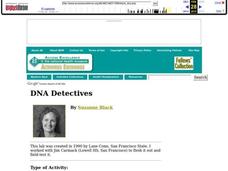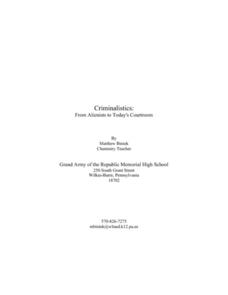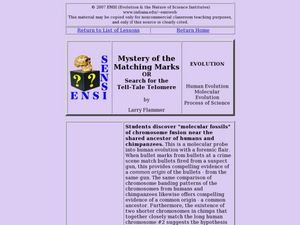Curated OER
DNA Fingerprinting
Students study the process of DNA Fingerprinting and how DNA Fingerprinting is used in solving crimes. They examine a crime scenario that involves collecting DNA Fingerprinting information from blood collected at the crime scene. They...
Cornell University
Plant Cell Crime Scene
Use science to solve the mystery of the Poplar murder. Pupils use forensic botany to determine if a suspect could be the killer. By analyzing images from a Transmission Electron Microscope, learners determine if the material found on the...
Curated OER
DNA Detectives
In order to understand DNA fingerprinting, advanced biology aces divise a crime scenario and analyze three different samples of lambda DNA. This creative lesson plan provides practice with micropipettes, electrophoresis boxes, and other...
Curated OER
The Great Cafeteria Caper
Students extract DNA from their own hair roots. They run an electrophoresis gel to examine patterns of their DNA along with standard DNA. The experiment is based on a crime scene scenario.
Curated OER
Flesh Eating Bugs, Moldy Corpses, The Trail of a Killer
Students read about how forensic entomologists use maggots to solve murders. In this forensic science lesson, students read an article and answer questions. They go to different websites about evidence and fingerprinting.
Towson University
Case of the Crown Jewels
Can your biology class crack the Case of the Crown Jewels? Junior forensics experts try their hands at DNA restriction analysis in an exciting lab activity. The lesson introduces the concept of restriction analysis, teaches pipetting and...
Curated OER
Who Did It?
Young scholars apply the concepts from forensic science lessons to do a lab. They solve a mystery using experimentation and observation. They write a technically correct lab report.
Curated OER
Mission Possible
Students, in teams, solve a crime using forensic lab techniques. They apply lab techniques to a real life situation using a crime scenario that takes place on campus. Sample activities include Blood, Fiber, and Hair Lab.
Curated OER
Who Is It?/Who Done It?
Students conduct an experiment that allows them to assess individual differences in random DNA sequences and apply those differences when solving a forensic problem. After discussing the polymerase chain reaction and its use to identify...
Curated OER
Create A DNA Fingerprint
Young scholars engage in a lesson that is about the DNA molecule and focuses upon the sequencing of proteins to identify individuals. They conduct research using a variety of resources and then complete the activities included in the 3...
Curated OER
Who's Who and How Do You Know for Sure?
Young scholars investigate the applications of DNA fingerprinting, They read crime scenarios and using the details of the crime and laboratory experimentation decide the suspects guilt or innocence.
Curated OER
Science: Criminalistics - A New Look at Crime
Students examine the world of forensic science, focusing on fingerprint analysis. In the lesson, they implement a method by which fingerprints of class members are categorized and identified. Elementary students study classification...
Curated OER
Blood, I Presume?
Students explain the value of blood in trials. In this DNA lesson students work together to collect and share information and ideas that they come up with after learning how to distinguish blood from other stains.
Curated OER
Genetics 5 Technology
Students, after studying extraction and gel electrophoresis, recombinant DNA, transgenic organisms, and reproductive cloning, summarize the main concepts in DNA technology. They analyze the applications of DNA: forensics, medicine,...
Curated OER
Applied Science - Science and Math Lab
Students examine fabric. For this Applied Science lesson, students look at the fibers of fabric through a microscope. Students compare and contrast a variety of fibers.
Curated OER
Mystery of the Matching Marks
High schoolers view a Power Point and complete activities related to genetic evidence of human evolution. In this molecular evolution lesson, students view and discuss a provide presentation. They search for the "tell-tale telomere" and...

















